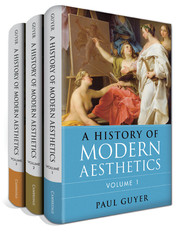Book contents
- Volume 1 The Eighteenth Century
- Frontmatter
- Epigraph
- Contents
- Acknowledgments
- Introduction
- 1 Prologue
- Part One Aesthetics in Britain, 1725–1800
- Part Two French Aesthetics in Mid-Century
- Part Three German Aesthetics between Wolff and Kant
- Part Four Kant and After
- 9 Kant
- 10 After Kant
- Bibliography
- Index
- Volume 2 The Nineteenth Century
- Volume 3 The Twentieth Century
- References
10 - After Kant
from Part Four - Kant and After
Published online by Cambridge University Press: 05 June 2015
- Volume 1 The Eighteenth Century
- Frontmatter
- Epigraph
- Contents
- Acknowledgments
- Introduction
- 1 Prologue
- Part One Aesthetics in Britain, 1725–1800
- Part Two French Aesthetics in Mid-Century
- Part Three German Aesthetics between Wolff and Kant
- Part Four Kant and After
- 9 Kant
- 10 After Kant
- Bibliography
- Index
- Volume 2 The Nineteenth Century
- Volume 3 The Twentieth Century
- References
Summary
In this chapter, we consider five writers whose work in aesthetics came on the heels of Kant’s Critique of the Power of Judgment: Karl Heinrich Heydenreich, whose own System of Aesthetics appeared just a few months after Kant’s third Critique; the great playwright and poet Friedrich Schiller, who, stimulated by Kant, was intensely engaged with philosophy during the first half of the 1790s; his great friend and patron Johann Wolfgang von Goethe; Wilhelm von Humboldt, the Prussian aristocrat who was an intimate of both Schiller and Goethe, who would later become the Prussian minister of education and moving spirit behind the establishment of the royal university in Berlin that now bears the name of Wilhelm and his brother, the renowned naturalist Alexander von Humboldt, and where so much of the development of aesthetics in the first decades of the nineteenth century would take place; and finally, for a second time, Johann Friedrich Herder, who in one of his very last works addressed a scorching critique at Kant’s aesthetics and, by extension, at those of Schiller as well. (The chapter concludes with a brief postscript on the philosopher Johann Friedrich Herbart.) With the exception of Herder, each of these figures accepted some elements of Kant’s philosophy but revised his aesthetics in other directions. Schiller was the only one of these authors to take Kant’s notion of free play seriously, while Heydenreich, the least well known of these authors, emphasized what Kant had tried to keep at arm’s length, namely, the importance of the emotional impact of art. Goethe and von Humboldt pushed back in the direction of a more traditional emphasis on the aesthetics of truth and thereby paved the way for the aesthetics of nineteenth-century German Idealism that we consider in the next volume. Herder, meanwhile, attacked Kant’s distinction between the mere agreeableness of sensory stimulation and the purer satisfaction afforded by the free play of the higher cognitive powers, a theme touched upon in passing by Goethe but not seriously developed until some of the twentieth-century responses to the Neo-Idealist Benedetto Croce, such as those of Samuel Alexander and Richard Wollheim. That is a matter for Volume 3, however.
- Type
- Chapter
- Information
- A History of Modern Aesthetics , pp. 459 - 532Publisher: Cambridge University PressPrint publication year: 2014



